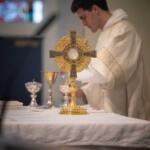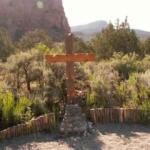As you travel, you will come across Catholic places of worship or prayer that have different titles, according to their purpose. These titles can all be a bit confusing, so we are giving you some helpful bits of information that you might find useful in your travels. Catholic places of worship have various titles depending upon their purpose.
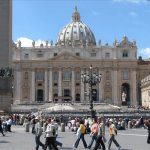
Basilica:
A Basilica is a designation for churches with historic significance, and only the pope can designate the title of a basilica. Basilicas are where the pope meets the people when he visits the diocese where the basilica is located. The pope can visit other churches and shrines as well, but the basilica is special in that it has a special chair with an umbraculum, an umbrella-like piece of regalia on the altar that symbolizes papal authority.
In addition to papal visits, other special ceremonies in the Church may take place in basilicas, like national vigils and saint coronations. Many basilicas also serve as the cathedral for their diocese, but not all basilicas are cathedrals.
Basilicas are designated as “major” and “minor” basilicas. There are only four major basilicas, based on their historical significance to the pope and all are located in Rome – Saint Peter’s, Saint John Lateran, Saint Mary Major, and Saint Paul Outside the Walls.
All other basilicas are minor basilicas, although very often the title may say Basilica without using the term minor Basilica. And the term “minor” in no way diminishes their importance. It simply differentiates them from the four Basilicas in Rome.
And just to make things a bit more confusing, you will sometimes find a Cathedral Basilica, such as the Basilica of Saint Louis, King of France in Saint Louis, Missouri. And, finally, a Basilica can also be a shrine, such as The Basilica of the National Shrine of the Little Flower in San Antonio, Texas.
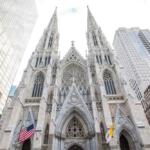
Cathedral:
A Cathedral is the mother church of a diocese. It is the home parish of the bishop. The cathedral of a diocese is also a parish, with its own parish community and parishioners. Thus, the cathedral parish is to a diocese what a county seat is to a county.
While the cathedral is the bishop’s parish, cathedrals also have rectors to help the bishop with the responsibilities of running the cathedral.
Co-Cathedral: A co-cathedral is a cathedral church which shares the function of being a bishop’s seat, or cathedra, with another cathedral, often in another city.
Chapel:
Many parishes have chapels inside their main church for daily Mass and adoration of the Blessed Sacrament. Chapels are sometimes separate from the main church structure. The function of a chapel is to serve as a location for more personal prayer or worship with smaller groups. In the image shown here a priest is elebrating Mass in the Chapel in St Jopseph’s Church…Greenwich Village, New York Cit
In many European and South American churches, you will often find several side chapels dedicated to various saints. In other churches, chapels may be located behind the main altar, in the basement of the church, or somewhere near the altar. And, of course, you will find chapels in Monasteries as well.
Some Chapels are not necessarily affiliated with a larger church, they are separate buildings. A chapel doesn’t have a permanent priest assigned.
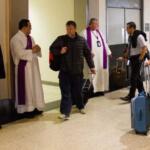 One example is chapels in airports...the Orthodox Mass Chapel in Bucharest is show here…and Catholics are invited to attend an Orthodox Mass.
One example is chapels in airports...the Orthodox Mass Chapel in Bucharest is show here…and Catholics are invited to attend an Orthodox Mass.
Speaking of airport chapels, you will find them especially busy on Ash Wednesday, when many Catholic travelers stop by to get their ashes. Photo on left courtesy Catholic Philly.
Monastery:
The place where religious dwell in seclusion. The term applies mainly to religious men or women who live a cloistered, contemplative life and recite the entire Divine Office in common. (Etym. Greek monastērion, from monazein, live alone.) Despite the term “seclusion”, many monasteries offer retreats: Silent and/or group retreats. An example of a monastery offering retreats would be Christ in the Desert Monastery in Abiquiu, New Mexico.
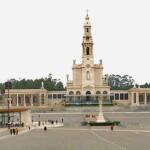
Shrine:
A Shrine is sometimes built on a spot where a significant supernatural encounter occurred, such as an apparition or a miracle. In other cases, it may be to honor a certain saint or have historical and cultural significance. Others may hold significance for being the burial place of a saint.
The Shrine of Our Lady of Fatima is a good example of a shrine built on the site of an apparition. One of the most significant and visited shrines in the world, it also includes several Basilicas: the Basilica of Our Lady of the Rosary and the Basilica of the Most Holy Trinity.
The Shrine of Fatima also includes several chapels: the Chapel of the Apparitions, among others…..confused yet?

Grotto:
A grotto refers to Catholic shrines built into a rock formation. Often these rock formations are man-made, but they can also be found in natural caves throughout the world.
A good example would be the Grotto of the Redemption in West Bend, Iowa.…entirely hand-made outside.
A grotto next to a parish church, a small roadside shrine or even a statue of a saint in a backyard can also be considered a shrine.
Other terms related to Catholic travel:
A pilgrimage: a journey to some sacred place as an act of religious devotion. It can be a long distance, or just a short way from home. A pilgrim is not just a tourist and a pilgrimage is more than just a journey.

